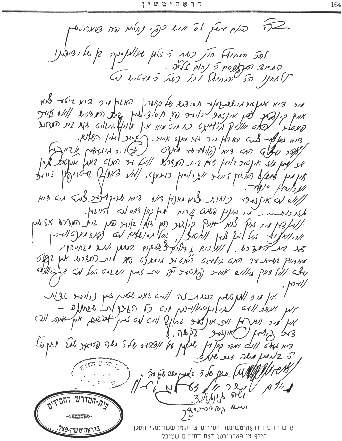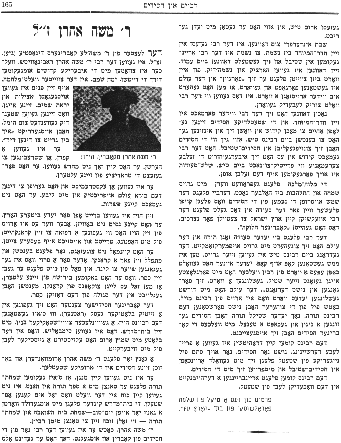
[Page 164]
[Handwritten letter from the Drohitchin chassidim to Zalman Shevinsky requesting assistance to repair the chassidim shtibel. The stamp is of the shtibel, Drohitchin, Polesia].

[Page 165]
After the Rebbe tasted something of the first course, he distributed pieces of bread to his chassidim around the table, and did this at every meal.
At Sabbath morning prayers, the Rebbe remained in his private room until the end of the preliminary hymns, and then entered the shtibel and served as cantor. He chanted all the prayers in a heartfelt and soulful manner, and from one word to the next he would start weeping. The congregants stood in amazement and waited for him to utter another word, which appeared as if he the Rebbe came back to life.
After the prayers, the Rebbe returned to his room, and the local chassidim hurried home to make kiddush and eat the morning meal with the intention of returning to the Rebbe to hear him recite the after-meal blessing. As soon as the chassidim returned to the shtibel, the Rebbe made kiddush and repeated the same ceremony as he had done the night before. He did the same thing at the third Sabbath meal.
The Saturday night meal [Melaveh Malka – Accompanying the departing Sabbath Queen] was conducted with great joy and enthusiasm until midnight. The shtibel custodian would then call out the names of the chassidim who had purchased the bottles of wine for the meal, and the Rebbe would arrange to send the money off to Palestine for distribution among the needy. This fund was called the Kobriner Fund.
The Rebbe would give Torah discourses at every meal, and the people would pay close attention to it, and there was a very large crowd around the Rebbe's table. People were practically standing on top of each other to be able to hear a few words uttered by the Rebbe as he spoke softly with his eyes rolled up. A word got swallowed, some crying, and nothing held back. The crowd thirstily swallowed every word he said, even though many people didn't understand his discourse. After he finished each part of the discourse, the chassidim would break out into singing or dancing, which the Kobrin chassidim were famous for.
The Rebbe's visit to Drohitchin was a happy occasion. Chassidim and other Jews in town would push their way into the shtibel to join the chassidim. His visit provided excitement for the entire week.
Information is from the article by Shlomo Podelevsky from the book, Horodetz
Rabbi Moshe Aharon
[Photo:] Rabbi Moshe Aharon of Kobrin
The last rebbe in the dynasty of R. Moshele Kobriner was the rebbe, R. Moshe Aharon Rabinovitch, who together with the remaining martyrs was killed in World War II by the Germans, may their names be obliterated. His face exuded high spirituality and fear of G-d. His eyes, always gazing heavenward, seemed to say 'I am ready to serve You.' R. Moshe Aharon was a meticulous person, without any aspiration to rule, and he didn't offer anything new; he just continued the tradition of his parents.
He was an extremist, and insisted that people serve G-d correctly and with love. He didn't allow for any compromise. His house was open to any bitter heart, but he didn't perform any miracles. However, whoever left his house was able to find a cure for whatever ailed him, carrying hope, comfort and an improved outlook for a better day.
The Rebbe never told promised anything; he merely offered blessings and prayers for a sick person or a mother experiencing difficulty in childbirth. In the event of hardship he would take a book that was handed down to him by his forbearers, and would rest it on the head of the sick person. People believed in the beneficial effect of his book.
The Kobrin chassidic center was located on a muddy side street (Rotner) at the location of the Rebbe's house. It was an ordinary two-story building with a House of Study. It was symbolic that around that mud and dirt was a spiritual life full of cleanliness.
All year long R. Moshe Aharon would visit his chassidim in surrounding towns. The Rebbe didn't sing songs, but when it came time for Simchat Torah, no power on earth could hold him back as he danced with a Sefer Torah in his hands. Children in the House of Study impatiently waited a whole year for Yomtof – the week of Sukkot and then Simchat Torah – to be able to dance with the Rebbe.
R. Moshe Aharon was only the rebbe of the chassidim in Kobrin and surrounding
Previous Page
|
Next Page
JewishGen, Inc. makes no representations regarding the accuracy of
the translation. The reader may wish to refer to the original material
for verification.
JewishGen is not responsible for inaccuracies or omissions in the original work and cannot rewrite or edit the text to correct inaccuracies and/or omissions.
Our mission is to produce a translation of the original work and we cannot verify the accuracy of statements or alter facts cited.
 Drogichin, Belarus
Drogichin, Belarus
 Yizkor Book Project
Yizkor Book Project
 JewishGen Home Page
JewishGen Home Page
Copyright © 1999-2025 by JewishGen, Inc.
Updated 13 Dec 2001 by LA